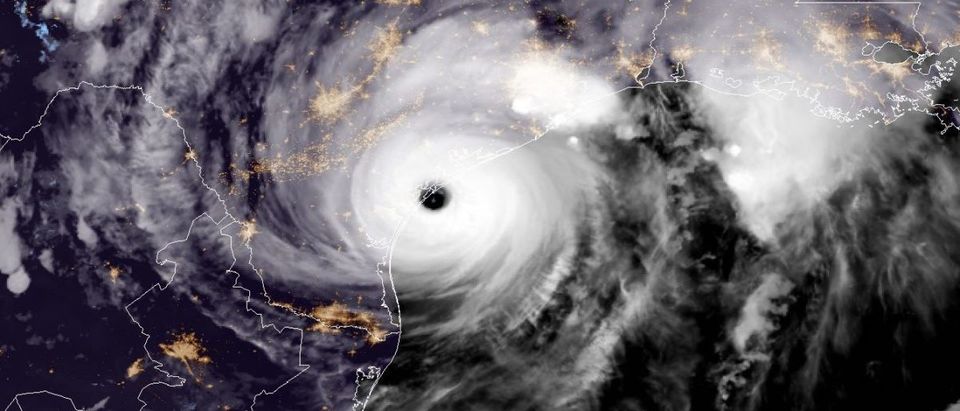Two new studies are out purporting to show a link between Hurricane Harvey and man-made global warming, sparking a wave of media coverage hyping the supposed climate connection.
But there are good reasons to be skeptical of both studies claiming to link a singular weather event like Hurricane Harvey to global warming.
The study by the group World Weather Attribution found (WWA) “that global warming made the precipitation about 15% more intense, or equivalently made such an event three times more likely.”
Scientists with Lawrence Berkeley National Laboratory (LBNL) found similar results, notably that “climate change likely increased Hurricane Harvey’s total rainfall by at least 19%” and made “likely increased the chances of the observed rainfall by a factor of at least 3.5.”
Major news outlets, including CNN and The New York Times, picked up on the studies, and the coverage was amplified by environmental activists. Even former Vice President Al Gore claimed the studies “link the climate crisis and Hurricane Harvey’s record rainfall.”
Both studies, of course, found global warming rainfall had increased more than expected, but both studies have some major caveats.
For starters, there are huge amounts of uncertainty when measuring rainfall statistics of a supposedly 1,000-year event. The relatively small increase in rainfall from global warming could be well within the bounds of uncertainty, Florida State University climatologist David Zierden noted.
Statistics of these kinds of extreme events have a WIDE range of uncertainty. Whether a 1000 yr event or 3000 yr., mostly indistinguishable withing 90% confidence interval. Example 4-day IDF curve for Lake Charles, LA. 2/2 pic.twitter.com/NTh1K6xNpX
— David Zierden (@FLClimateCenter) December 14, 2017
The WWA study, like most “attribution” research, relies on climate models to provide “a counterfactual climate without anthropogenic influences, such as the emissions of greenhouse gases.” While LBNL scientists simply looked at observational rain gauge data.
However, neither study addressed the main reason Harvey dumped record amounts of rainfall over southeastern Texas and Louisiana — it stalled over land.
In late August, Harvey stalled over the greater Houston area for several days before going back in the Gulf of Mexico, dumping record amounts of rain. That is the primary reason so much rain came down, rain which would have otherwise been spread over a greater area.
WWA authors said they indirectly took Harvey’s stalling into account because such patterns are built into the models, but the study only looked at Harvey’s rainfall totals, not its other characteristics.
“There are stalling hurricanes in the observational dataset, and there are stalling hurricanes in the model output, and these indeed contribute heavily to the extreme precipitation events that we compare Harvey with,” Geert Jan van Oldenborgh, lead author of the WWA study, told The Daily Caller News Foundation.
This isn’t the same as looking at individual storms. Storms are complex and rely on a mix of climatic conditions to develop, which is why it’s difficult to tie them to global warming.
“It’s clear that Harvey’s exceptional rainfall was due to the stalling and looping nature of the track of the storm — which this study does not address in the slightest,” Ryan Maue, a meteorologist with Weather.us, told CNN.
In fact, the LBNL study acknowledged that “Hurricane Harvey was an unusual storm largely due to the lengthy period it spent stalled over Texas.”
“Precipitation rates were not particularly unusual for a hurricane of this magnitude and the human-induced changes to precipitation metrics that consider less than the seven-day storm total are smaller than the results presented here,” LBNL authors admitted.
Both studies also relied on rain gauges to measure Harvey’s rainfall, meaning the data is vulnerable to man-made change that has nothing to do with the climate.
The WWA study admitted “that other anthropogenic factors have contributed to increased flood risk in Houston, specifically urban development … and resource withdrawal that has led to subsidence of up to” 10 feet.
Not taking Harvey’s stalling into account also complicates this matter. Looking at rainfall totals doesn’t tell you about the weather patterns and overall atmospheric conditions contributing to the storm.
Follow Michael on Facebook and Twitter
The Daily Caller News Foundation is working hard to balance out the biased American media. For as little as $3, you can help us. Freedom of speech isn’t free. Make a one-time donation to support the quality, independent journalism of the Daily Caller News Foundation. We’re not dependent on commercial or political support and we do not accept any government funding.
All content created by the Daily Caller News Foundation, an independent and nonpartisan newswire service, is available without charge to any legitimate news publisher that can provide a large audience. All republished articles must include our logo, our reporter’s byline and their DCNF affiliation. For any questions about our guidelines or partnering with us, please contact licensing@dailycallernewsfoundation.org.



